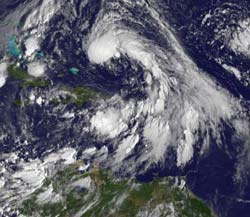

A subtropical storm is one where central convection (rapidly rising air that forms thunderstorms) is fairly near the center and it has a warming core in the mid-levels of the troposphere. Subtropical cyclones differ from tropical cyclones because they have broad wind patterns and their maximum sustained winds are located farther from the center of the system than tropical cyclones.
In addition, they usually have colder temperatures in upper levels of the atmosphere than tropical cyclones (which have very warm cores). Finally, sea surface temperatures required for the formation of sub-tropical storms are about 5 degrees Fahrenheit cooler than needed for a tropical cyclone to develop (80 F).
TD17 is forecast by the National Hurricane Center to move into a more favorable environment to develop, and its core may warm up making it into a tropical depression or tropical storm, if it intensifies.
The Geostationary Operational Environmental Satellite called GOES-13 captured an infrared image of TD17 on October 6 at 1231 UTC (8:31 a.m. EDT). GOES satellites are managed by NOAA. NASA's GOES Project at NASA's Goddard Space Flight Center in Greenbelt, Md. creates images and animations from the satellite data and created today's image that shows TD17 has a tight circulation and a long “tail” of clouds and showers that extend to the southeast of the center, reaching the northern Leeward Islands and Puerto Rico.
At 5 a.m. EDT on Oct. 6, TD17's maximum sustained winds were 35 mph. It was located about 270 miles north-northwest of San Juan, Puerto Rico and 710 miles south of Bermuda near 22.2 North and 67.0 West. It was moving northwest at 8 mph with minimum central pressure of 1001 millibars. TD17's “tail” extends to the southeast from the center of the system, and may bring some heavy rainfall in the northern Leeward Islands and Puerto Rico over the next day as it moves northwest then turns northeast to head out to the open waters of the Atlantic.












